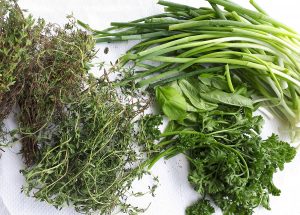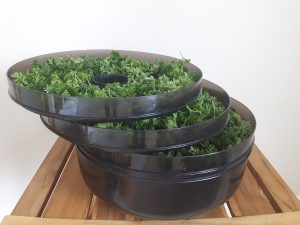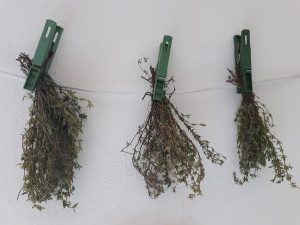In the Garden
By Claudette Russell
Parsley, Sage, Rosemary and Thyme, and so many more
 As a curious gardener, you may turn your attention to growing herbs at some point in your gardening journey. The options are much more varied than the four herbs mentioned in Scarborough Fair, the popular 1968 song by Simon and Garfunkel.
As a curious gardener, you may turn your attention to growing herbs at some point in your gardening journey. The options are much more varied than the four herbs mentioned in Scarborough Fair, the popular 1968 song by Simon and Garfunkel.
If you have tried growing herbs, you’ll know that they produce more than can be used fresh once the plants are established. And, while fresh is always better, the next best thing is dried herbs that came from your own garden. This is the main reason that I started drying herbs.
Herbs hold a special place in my garden for another reason. I have fond memories of the important role they play in my Caribbean culture. My grandmother believed that any disease or illness
could be cured by some combination of herbs and spices. If anyone had a sore throat, she would quickly prepare lemongrass and ginger tea with a touch of honey or white rum. Swollen joints? —turmeric and coconut oil paste. Menstrual cramps? —feverfew tea. There was always a rich assortment of fresh herbs in her garden, and she swore to their ability to cure any ailment.
While I feel the need to pay homage to my grandmother, the techniques highlighted here are for drying herbs for flavour and/or fragrance, recognizing that any medicinal benefits of herbs are
both highly complex and highly controversial.
Here are some tips to help you achieve the best results.
 Harvest the healthiest parts of the plant before it starts flowering. Mornings are the best time of the day. Some will advise that plants should not be rinsed before starting the drying process, but I disagree. Most herb plants will pick up dust and dirt from soil or wind and rain. I dunk the harvested plants in a bowl of cold, lightly soapy water to get rid of dirt and bugs, then more dunks in clean water and then I shake off the excess water. I put them on a tea towel and leave them in the fridge for a few hours. This will help to remove additional surface moisture and keep the plants fresh. When the surface moisture has been removed, the herbs are ready for drying.
Harvest the healthiest parts of the plant before it starts flowering. Mornings are the best time of the day. Some will advise that plants should not be rinsed before starting the drying process, but I disagree. Most herb plants will pick up dust and dirt from soil or wind and rain. I dunk the harvested plants in a bowl of cold, lightly soapy water to get rid of dirt and bugs, then more dunks in clean water and then I shake off the excess water. I put them on a tea towel and leave them in the fridge for a few hours. This will help to remove additional surface moisture and keep the plants fresh. When the surface moisture has been removed, the herbs are ready for drying.
To dry herbs, use one of three methods: oven or microwave drying, dehydrator, or air drying. The method you use depends on personal preference as well as the water content of the plant. Leafy herbaceous plants with high water content generally require different drying techniques than woody plants.
I rarely use an oven or microwave to dry herbs. I have found it challenging to maintain a temperature in the oven that does not overcook or burn the plant, reducing the quality of the herb. Spread out each plant evenly in a single layer on a baking sheet. Keep leaves and stems intact and, try not to rub or damage leaves. Preheat your oven to the lowest temperature possible, open the door, turn the oven off and place the baking sheet of herbs in the oven. Rotate the baking sheet occasionally for even drying. You may need to repeat this step several times. Herbs are perfectly dried when the leaves crumble and separate from the stem effortlessly. They are now ready to be stored in an air-tight container.
The process for microwave drying is similar but takes much less time. I would recommend trying a small amount at a time, at a high-power level, for one minute or less. Repeat as needed.
 By far, my favourite method for drying herbs is using a dehydrator. I received a 30-year-old dehydrator from my aunt which has three stackable trays that allow me to dry a large quantity of herbs at a time. Depending on the herb, it can take up to eight hours to complete the drying process. More sophisticated dehydrators on the market today have timers, adjustable temperatures, fans, and other bells and whistles that allow for more accurate and efficient drying. But my aunt’s dehydrator has served me well over the years.
By far, my favourite method for drying herbs is using a dehydrator. I received a 30-year-old dehydrator from my aunt which has three stackable trays that allow me to dry a large quantity of herbs at a time. Depending on the herb, it can take up to eight hours to complete the drying process. More sophisticated dehydrators on the market today have timers, adjustable temperatures, fans, and other bells and whistles that allow for more accurate and efficient drying. But my aunt’s dehydrator has served me well over the years.
Air drying is also a viable option and much more environmentally friendly. You can dry herbs outdoors but avoid damp mornings and evenings, as well as air pollutants. For best results, hang them in bunches upside down in a warm, dry location indoors with good air circulation—after five to 10 days, they should be ready to store.
Some herbs, especially those with a high, water content, can be more challenging to dry, no matter what drying method is used. I freeze these rather than dry them. Separate the leaves from the stems, rinse and put them directly in a zip lock bag in the freezer until you’re ready to use them. If you want to be more creative, put herbs in olive oil or water in ice cube trays and freeze. Once they are completely frozen, pop them out of the tray and store them in the freezer in a zip lock bag.
In the lyrics of the song Scarborough Fair, the four herbs mentioned represent four virtues—parsley is comfort, sage is strength, rosemary is love, and thyme is courage. This may be too much to ask from the herbs in your garden, but I can assure you that when you use your dry garden herbs in the middle of winter, your roasted vegetables and stews will show you and your family an abundance of flavour and maybe some comfort and love.
Claudette Russell has been gardening on her two acre lot in Carlsbad Springs, in the rural southeast corner of Ottawa, for 20 years. She volunteers with Master Gardeners of Ottawa-Carleton and is constantly experimenting with different plants to make her garden better and more interesting every year.
Which herbs for which method?
Oven and microwave drying
It can be tricky to dry herbs in the oven. Take care not to overcook or burn, which will destroy the natural oils and flavour. Two herbs that do well with oven drying are:
Lemongrass
Chives
Dehydrator
All herbs will dry well in a dehydrator. Some of my favourites are:
Parsley
Oregano
Beebalm
Sage
Lemon verbena
Ginger slices
Air drying
Herbs that have a low water content are good candidates for air drying. Some good candidates are:
Lavender
Sage
Thyme
Rosemary
Lemongrass
Cannabis leaves
Freezing
Herbs that have high water content can rot or mould before they have time to dry. Freezing offers a better way to preserve the flavour. Some herbs that freeze well are:
Basil
Mint
Dill
Chives
Cilantro
Peppermint






